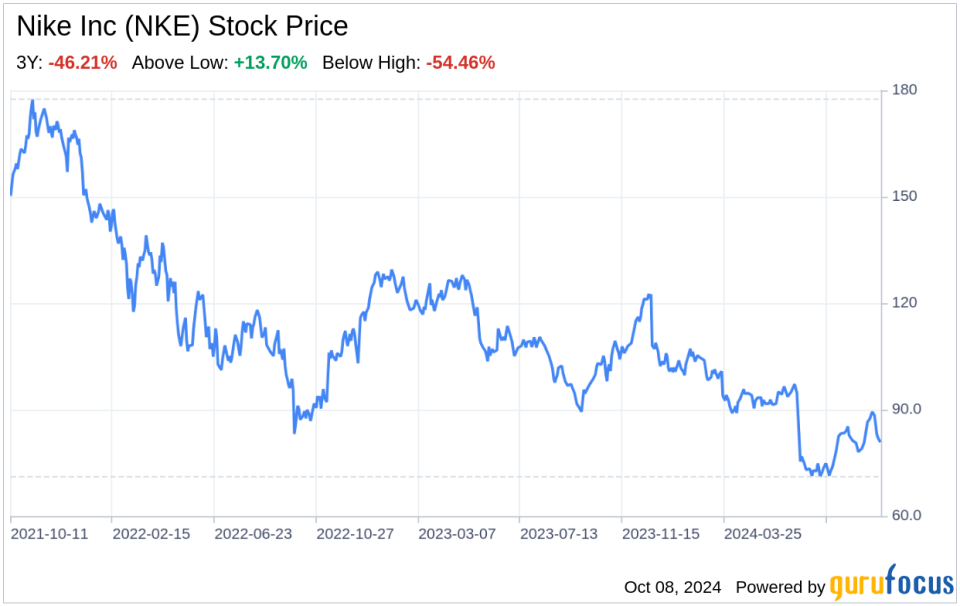Decoding Nike Inc (NKE): A Strategic SWOT Insight
Insightful examination of Nike Inc's strengths including robust brand recognition and innovative product offerings.
Analysis of Nike Inc's weaknesses, such as supply chain complexities and market saturation risks.
Exploration of opportunities for Nike Inc, including digital transformation and global market expansion.
Assessment of threats facing Nike Inc, from competitive pressures to geopolitical uncertainties.
On October 7, 2024, Nike Inc (NYSE:NKE) filed its 10-Q report, revealing a mixed financial performance with revenues of $11.589 billion, a decrease from the previous year's $12.939 billion. Despite this decline, the company maintained a strong gross profit of $5.257 billion, though it was lower than the prior year's $5.720 billion. Net income also experienced a downturn, coming in at $1.051 billion compared to $1.450 billion in the previous year. This financial overview sets the stage for a deeper SWOT analysis of Nike Inc, as we explore the strengths, weaknesses, opportunities, and threats that shape the company's strategic outlook.

Strengths
Global Brand Dominance: Nike Inc's brand is one of its most significant assets. The company's logo and slogan "Just Do It" are universally recognized, contributing to a loyal customer base and a commanding presence in the athletic footwear and apparel industry. This brand strength is reflected in the company's ability to maintain a substantial gross profit margin, even amidst a revenue decline, as indicated in the latest 10-Q filing.
Innovative Product Pipeline: Nike Inc is renowned for its commitment to innovation, consistently introducing new products that set industry trends. This dedication is evident in the company's substantial investment in demand creation, which increased to $1.226 billion from $1.069 billion year-over-year. The company's innovation extends to its digital platforms, which are crucial for engaging with tech-savvy consumers and driving future sales growth.
Financial Health: Despite a decrease in net income, Nike Inc's balance sheet remains robust. The company's earnings per share (EPS) stood at $0.70, down from $0.94 the previous year, yet still indicative of financial resilience. Nike Inc's ability to generate substantial cash flows enables it to invest in growth initiatives and return value to shareholders, as evidenced by the $1.8 billion returned through share repurchases and dividends.
Weaknesses
Supply Chain Vulnerabilities: Nike Inc's reliance on outsourced manufacturing introduces complexities in its supply chain. The recent financials show the impact of these vulnerabilities, with cost of sales amounting to $6.332 billion, a significant portion of the revenue. These complexities can lead to challenges in maintaining product quality and meeting consumer demand in a timely manner.
Market Saturation Risks: As the largest athletic footwear and apparel brand, Nike Inc faces the challenge of market saturation. With a vast product range and global reach, finding new avenues for growth can be difficult, and the company must continuously innovate to stay ahead. The decrease in revenue suggests that Nike Inc may be experiencing the effects of operating in a highly competitive and mature market.
Foreign Currency Fluctuations: Nike Inc's international operations expose it to foreign currency risks. The 10-Q filing highlights the impact of currency fluctuations on the company's financials, with net gains and losses on cash flow hedges affecting the comprehensive income. These currency risks can lead to unpredictability in earnings and may complicate financial planning.
Opportunities
Digital Transformation: Nike Inc's e-commerce platforms are a significant growth opportunity, especially as consumer shopping habits increasingly shift online. The company's investment in digital initiatives, as part of its NIKE Direct operations, positions it to capitalize on this trend and enhance its direct-to-consumer sales channels.
Emerging Markets Expansion: While Nike Inc has a strong presence in established markets, there is potential for expansion in emerging economies. These regions offer new customer bases and the chance for Nike Inc to increase its global market share. The company's strategic investments in marketing and localization of product offerings can drive growth in these untapped markets.
Sustainability Initiatives: Consumers are becoming more environmentally conscious, and Nike Inc's focus on sustainability can be a differentiator. By developing eco-friendly products and reducing its carbon footprint, Nike Inc can appeal to a growing segment of consumers who prioritize sustainability, potentially leading to increased brand loyalty and sales.
Threats
Intense Competition: The athletic footwear and apparel market is highly competitive, with numerous brands vying for market share. Nike Inc must continually innovate and market effectively to maintain its leadership position. Competitors' aggressive strategies could erode Nike Inc's market share and pressure profit margins.
Geopolitical Uncertainties: Global trade tensions and geopolitical issues can disrupt Nike Inc's supply chain and affect its international sales. The company's extensive global operations make it susceptible to such risks, which could lead to increased costs or barriers to market access.
Consumer Behavior Shifts: Changing consumer preferences and the rise of alternative fitness and lifestyle trends can impact Nike Inc's product demand. The company must stay attuned to these shifts to ensure its product portfolio aligns with consumer expectations and to avoid inventory excesses, as indicated by the 10% inventory increase reported in the 10-Q filing.
In conclusion, Nike Inc's SWOT analysis reveals a company with formidable strengths, including a powerful brand and a commitment to innovation, balanced by weaknesses such as supply chain complexities and market saturation challenges. Opportunities for growth through digital transformation and emerging market expansion are tempered by threats from intense competition
This article, generated by GuruFocus, is designed to provide general insights and is not tailored financial advice. Our commentary is rooted in historical data and analyst projections, utilizing an impartial methodology, and is not intended to serve as specific investment guidance. It does not formulate a recommendation to purchase or divest any stock and does not consider individual investment objectives or financial circumstances. Our objective is to deliver long-term, fundamental data-driven analysis. Be aware that our analysis might not incorporate the most recent, price-sensitive company announcements or qualitative information. GuruFocus holds no position in the stocks mentioned herein.
This article first appeared on GuruFocus.